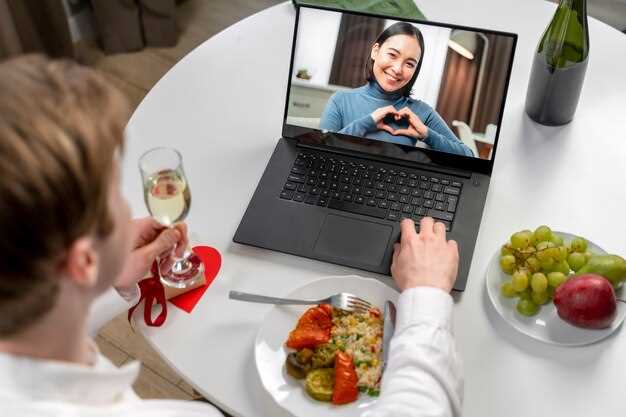Skip long text threads and schedule a 15-minute video date to test chemistry fast. In a quick call on video or facetime, you can see if the person’s energy matches yours, and you’ll learn how they respond to light humor or serious topics without guessing from a photo alone. A short first date reduces the worry of misreads and makes distance feel closer, so you don’t back into endless scrolling. This approach supports avoiding misreads and helps you see who you’re really talking to, not just a profile for a month. If you want a reliable first step, I recommend trying a video date.
Reason 2: It reveals personality and voice, not just looks. When you hear the other person’s voice and see their expressions, you get a feel for how they handle questions and listen. This makes it easier to decide if they’re the kind of person you want to keep talking to. You’ll notice micro-gestures, tone shifts, and how they react to your humor–elements that text can’t capture, and they help you decide whether to continue the conversation with someone you actually connect with. This clarity helps you pick the best match faster.
Reason 3: It saves time in a busy month. Instead of waiting weeks for a date, you can line up several brief sessions over a few days, freeing up your calendar for better options. You’ll avoid wasting time with profiles that don’t match your deal-breakers, and you’ll get a clearer read about fit–without leaving the app. Many people who try video dates find they can identify red flags early and move on quickly.
Reason 4: It works with real life, pandemic habits, and evolving routines. Even if you live far away, video dates reduce distance and make it easy to fit a first chat into a free window between commitments. As more people adopt video conversations for dating, you’ll find a growing trend of trustworthy connections before meeting in person. After a few sessions, you’ll know if you want to take the next step and meet in the real world, or keep it simple and stay online.
Video Dates and AI-Driven Compatibility: A Practical Guide
Begin with a 10-minute video date and a clear intention: identify one shared value and one area of curiosity.
To maximize connection, use AI-driven prompts that translate conversations into a practical view ahead of meeting in person. The approach blends data from sites and apps with real-time feedback, keeping your pace natural and your mood relaxed.
-
Pick platforms that support in-app video dates and smart prompts. Look for sites and apps that allow you to export notes after each chat, so you can compare theirs responses with your own needs and intention. Keep your home setup quiet, with good lighting, so you feel comfortable and confident.
-
Map needs and intention up front. Use a brief AI prompt to list 3 non negotiables and 2 curiosities. Such a baseline helps the system suggest compatible matches and lets you track progress across stages. Examples include values like honesty, humor, and reliability, plus topics you’re excited to explore together.
-
Structure the conversation into stages. Stage 1 covers light topics to build comfort and a natural laugh cadence; Stage 2 dives into values, goals, and daily habits; Stage 3 sets the next step, whether a second date or a clear view ahead of compatibility. This leap from casual to meaningful reduces trivia-style chatter and speeds up real insight.
-
Use external cues and AI insights to guide the discussion. Lighting, background, and pacing matter, but AI can highlight moments you cant miss–like when someone cant commit to a plan or when they show consistent energy. The system allows you to compare tone, follow-up clarity, and responsiveness across different chats without denying genuine signals.
-
Incorporate light, evidence-based prompts and trivia. Such questions help you gauge compatibility while keeping the vibe friendly. For instance, ask about a favorite weekend ritual or a small risk they once took–these are great for revealing character without turning the date into an interview.
-
Capture a clear compatibility view and acting plan. After each session, log a quick note: what worked, what felt off, and what you’d like to explore next. The AI can summarize patterns across several dates, showing how well someone aligns with your needs and how fast you can progress.
-
Set boundaries with donts and practical expectations. Dont overshare personal details too soon, dont rely on a single chat, and dont assume a great connection means a lifelong match. If the data shows a mismatch on key items, consider steering the next conversation toward a fresh angle or a safer next step.
-
Support newer connections while protecting your time. If a date shows consistent lighthearted chemistry but misses core needs, suggest a longer video session to test consistency or pivot to a different match in the same apps. You can always deny proceeding if signals stay negative, but use the data to decide quickly rather than clinging to doubt.
-
Make the most of the human element. Men and women alike respond to thoughtful prompts and genuine listening. Having a respectful tone, the ability to laugh together, and a clear plan for the next step often yields the best outcomes. For example, a few tailored questions can turn a casual chat into a meaningful connection, and the resulting momentum tends to persist across future chats.
Key takeaways: begin with a concrete plan, use AI to enhance your intuition rather than replace it, and view each date as part of a larger process. By aligning stages, needs, and intention, you create a smoother path toward meaningful connections on newer platforms. This method makes video dates more than trivia; it builds real comfort, faster learning, and a practical route to a shared next step with someone you might genuinely like.
Minimize first-date nerves by reading real-time nonverbal cues on video
Begin with a 6-minute video chat and a 15-second warm greeting to lower nerves. Having a clear plan in the first moments helps you choose topics that feel natural, setting a pace that keeps things light and friendly.
If youre nervous, acknowledge it politely and keep pace. This simple honesty reduces tension and signals you respect the other person’s time.
- Setup and frame: keep lighting natural, camera at eye level, and a quiet space. A free, clean medium shot makes your face readable and adds warmth.
- Read nonverbal cues: open posture, relaxed shoulders, and consistent eye contact signal compatibility. When you notice signs of warmth, respond with a smile and a longer answer to deepen intimacy.
- Reflect and respond: politely acknowledge cues, mirror small movements, and keep the dialogue flowing. If you notice tension, trying to steer to something playful helps.
- Handling bumbles: when a small bumble happens, acknowledge with grace and deny the urge to rush. Suggest asking a quick, playful question to reset the tempo.
- Confirming compatibility: end with a concrete signal, like “I enjoyed this,” and choosing to schedule a face-to-face meet if the vibe is good. This confirms you both are compatible, not a gamble.
- Post-call follow-through: invite continued interaction via a feature in the app, and keep it warm; users who do this feel better about the choosing to stay in touch.
- Measurement and trend: track how the vibe evolves through interactive prompts that solicit feedback; this keeps the process free from guesswork and helps you improve the next date.
Understand AI-driven compatibility analysis: which signals it weighs and why they matter
Start by prioritizing three signals: warmth in tone, reliability in replies, and alignment on core interests to boost long-term matches. They help you find matches with real romance and close bonds.
In real-world interactions, those signals surface during calls and in how couples build bonds; theyre easy to misread, so AI helps separate signal from noise and shows where romance has room to grow.
AI-driven compatibility analysis weighs signals such as response quality and emotional warmth, cadence consistency, topic overlap, and the clarity of plans. It examines not only what you write but how you present yourself across messages, voice calls, and live moments. Anything you reveal should be honest, because AI learns from consistent patterns. These signals matter because they predict whether two people can move from chats to dates, plan the next steps, and sustain connection over time. They also indicate where your values align and where sparks tend to fade.
To influence these signals, craft concise but vivid examples of your interests, propose concrete activities that align with shared hobbies, and practice storytelling that shows your values. When choosing what you share, keep it close to reality so the AI can match you with real-world partners who have been through similar moments. For instance, recount a memorable date, a travel story, or a problem you solved together–these show special traits that tend to translate into lasting matches.
Use the data from these signals to plan the next conversations: set a date for a video call, suggest a casual in-person meet, or pick a theme for your next chat. If the signals point to potential alignment, you’re more likely to get a leap in connection and plan a second meeting, move toward live meetings.
| Signal | Почему это важно | How to improve |
|---|---|---|
| Communication warmth | Conveys trust and emotional safety, predicting close bonds. | Use respectful language, mirror questions, acknowledge feelings in replies. |
| Последовательность | Shows reliability across days and calls, reducing uncertainty. | Maintain a steady cadence, follow through on plans, and avoid long gaps. |
| Shared interests | Increases chances of enjoyable activities and plans you can pursue together. | Highlight concrete hobbies, ask about experiences, and propose joint experiments. |
| Response patterns | Indicates how well you handle busy periods and misreads. | Respond promptly, ask clarifying questions, and keep messages clear. |
| Story alignment | Reveals what you value and how you approach romance. | Offer short, real-world anecdotes that reflect your plans and sensitivities. |
Next steps: review the signals after each conversation, plan the next interaction around what the AI highlights, and continue to optimize your approach to get matches that feel special and real.
Prepare a 15-minute video-date plan: questions, setup, and flow
Plan a 15-minute video date with a tight rhythm: 0-3 minutes warm-up, 3-7 minutes discovery, 7-12 minutes shared activity, 12-15 minutes wrap. This frame is great because it keeps both people engaged and lets you gauge chemistry quickly. Use zoom for the calls and keep the medium simple to reduce setup friction, here you can test sound and lighting before you begin.
Draft six questions that invite a vocal reply and keep authenticity clear. Each prompt stays light, with safety in mind, and can be answered in under 60 seconds. Here are examples you can adapt: 1) What small moment this week made you smile? 2) If you could open a door to one real-world place, where would you go and why? 3) What hobby would you start if you had a free weekend? 4) Which show or book would you recommend to someone you just met digitally? 5) Tell me about a moment you felt very understood by someone. 6) What’s one value you’d want a date to reflect? You can mix in personal stories to feel more authentic; this approach confirms vibes before you move forward.
Setup tips: create a cozy space with soft lighting, a clean background, and minimal echo. Do a quick test call digitally to enable sound and video checks. Place the camera at eye level so the other person feels seen; this keeps you connected. Use a quiet room, mute when not talking, and avoid busy visuals to help the conversation stay focused. If you cant relocate, use headphones and a simple mic to improve safety for both sides.
Flow and timing: start with warm, easy questions, then move to a brief show-and-tell or a quick task, and wrap with a clear next step. Keep each block under 3 minutes and allow a 1-minute buffer for any delay. At 12 minutes, suggest a second call or plan a real date; that confirms interest without pressure and keeps the vibe cozy. If mood seems off, switch to a lighter topic and let the other person steer the pace; the goal is authentic connection, not a perfect performance.
Choose the right time and pace: scheduling tips across time zones and busy calendars
Lock a 60-minute video date in the first viable overlap of your calendars, with a 10-minute prep and 5-minute wrap-up. This creates ground to be authentic and build bonds, and it keeps the pace comfortable across time zones with some energy.
Navigate across zones by identifying 2-3 candidate windows that work in both zones, and lock one anchor slot each week. Use a curated, time-zone-aware calendar and label slots as connections where the purpose is clear. If a slot lands on a busy day, shift to the next viable option rather than cancel; this approach refines momentum through those long weeks and preserves boundaries. If a slot isn’t viable, try a shorter 20-minute call rather than canceling.
Set pacing with stages: start with a first call, then a second video date within 1-2 weeks, moving toward deeper bonds as comfort grows. Limit calls to 2 per week or fewer if calendars are tight; if energy dips, slow down rather than force the pace. This keeps relationships authentic, makes needs visible, and strengthens the bonds rather than burning out.
Before each date, run a quick tech check and map out a simple agenda that respects boundaries. Agree on a short discussion about expectations, and end with a friendly sign-off (xoxo) to mark a positive note. Plan transportation from distance into your routine so the event feels natural rather than rushed, creating place for better connections and great outcomes, and a sense of being very present in the moment.
Translate a video date into action: a simple scoring rubric for next steps
Score the video date immediately with a simple 0-5 rubric across five criteria to decide your next step: be authentic, ease of conversation, safety, viability for a real meetup, and the clarity of the follow-up plan. This turns a date into a concrete plan rather than a vague vibe check.
Authenticity: Rate how genuine the exchange felt, whether stories felt personal, and whether you sensed real interest beyond small talk. A high score appears when you can recall specific details, you felt natural on camera, and you would say yes to meeting again without making excuses. If responses feel canned or you sense a deny of genuine interest, drop the score.
Communication ease: Measure pace, listening, clarity, and ability to switch topics without awkward gaps. Great video dates show a smooth flow, fewer clipped answers, and moments you both engage – you would talk again without forcing topics. A high score means you would enjoy regular conversations with less friction; a low score signals ongoing friction.
Безопасность и комфорт: Judge if you felt safe sharing personal details, if boundaries were respected, and if you felt comfortable being yourself. Positive signals include respectful tone, clear consent for sharing stories, and no pressure to press private topics too soon. Higher points indicate ease in continuing the conversation with confidence.
Viability for meeting in person: Consider how viable a real meetup feels given location, timing, and your chemistry. If you both express a casual plan to meet over coffee or a walk, score high. If you feel the interest is only online or you’re facing repeated scheduling friction, score lower. This metric helps you decide whether to make a newer move or pause.
Next-step clarity: Is there a concrete next step or a reason to pause? Look for a specific follow-up action, such as “we’ll talk again tomorrow” or “I’ll send a link to a place we could try.” If a clear plan exists, add points; if not, save the energy for another date or for a different conversation with friends.
How to apply: assign 0-5 for each criterion, total 0-25. If your score is 18-25, you have a viable signal to escalate toward an in-person meetup or a longer chat. A score of 12-17 suggests another video date could help, but keep expectations realistic. A score below 12 means the fit is not strong enough to justify more time with this person, and you can close the loop politely.
Tips to improve future video dates: pick a free, low-pressure environment, prepare a few open-ended questions, and share authentic experiences. Concentrate on the stories you heard, note what feels engaging, and gauge the contrast with other daters on Zoosk. If the other person shows interest in your friends and relationships, you gain a stronger signal.
Use these steps after every video date to stay consistent and avoid bias in your choices.

 4 причины, почему видео-свидания — это ответ на ваши молитвы об онлайн-знакомствах">
4 причины, почему видео-свидания — это ответ на ваши молитвы об онлайн-знакомствах">


 Мой подкаст о свиданиях и отношениях с Шанталь Хайде – Тренер по свиданиям Канады">
Мой подкаст о свиданиях и отношениях с Шанталь Хайде – Тренер по свиданиям Канады">
 Что сказать в Tinder — первые фразы и темы для разговора, чтобы получить больше совпадений">
Что сказать в Tinder — первые фразы и темы для разговора, чтобы получить больше совпадений">
 6 Guaranteed Benefits of Dating Coaching">
6 Guaranteed Benefits of Dating Coaching">